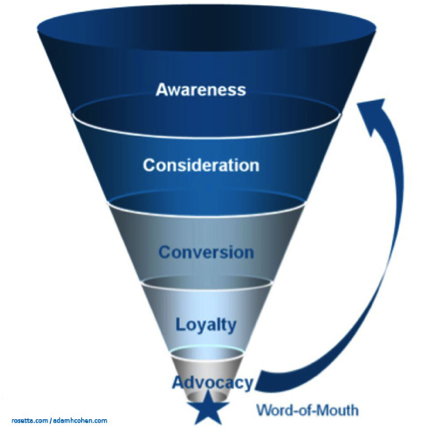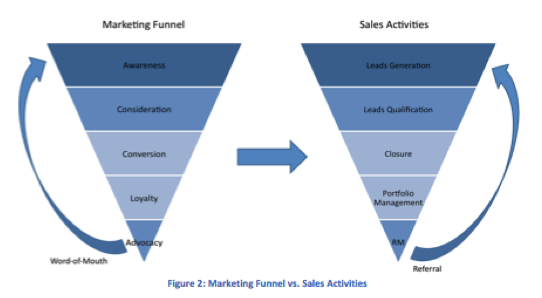Aligning Marketing and Sales in a Web 2.0 World
Please note that we are not authorised to provide any investment advice. The content on this page is for information purposes only.
We all have seen it many times before: the marketing team in a corporation accuses the sales team for not following up properly on the leads given to them; whereas the sales team counters by saying marketing is wasting the salespeople’s time by giving them useless random contacts. While the truth probably lies somewhere in between, the constant struggle between marketing and sales creates a drag on any organization that strives to drive greater revenue growth.
We all have seen it many times before: the marketing team in a corporation accuses the sales team for not following up properly on the leads given to them; whereas the sales team counters by saying marketing is wasting the salespeople’s time by giving them useless random contacts. While the truth probably lies somewhere in between, the constant struggle between marketing and sales creates a drag on any organization that strives to drive greater revenue growth.
Although the marketing-sales tussle is not a new issue, it is accentuated by recent advancement in technology and changing consumers’ purchasing behaviors. Indeed, these developments have changed the traditional marketing funnel from a simple 3-step process of Awareness-Consideration-Purchase, to something more evolved as suggested by Adam Cohen, partner at digital agency Rosetta based in the United States [1]:
Figure One: The New Marketing Funnel, By Adam Cohen
According to Cohen, the widespread adoption of Customer Relationship Management (CRM) in the 1990s had forced marketers to focus more on “Loyalty” or customer retention thus bringing the funnel a layer deeper. At the same time, peer recommendation is becoming more influential in a consumer’s purchasing decision, facilitated by Web2.0 technologies and the emergence of social media. This causes the new marketing funnel to be further extended to the “Advocacy”, which forms the foundation for future Word-of-Mouth marketing.
The new marketing funnel adds further complexities to the tussle between marketing and sales. This is because in the past, sales teams typically take over after the awareness (i.e. largely advertising) stage and follow-up with prospective customers by feeding them with more detailed product or service information. In a Web2.0 world, this information asymmetry has largely been removed and today’s buyers often are as knowledgeable as the sellers. As a result, the distinction between marketing and sales are becoming increasingly blurred: marketing now has to play a more active role in the consideration stage whereas salespeople are often more effective in converting a customer to an advocate than a generic customer loyalty program designed centrally.
While the new marketing funnel provides a solid theoretical framework for reaching out and engaging customers in a Web2.0 world, we still need to link it up with actual activities undertaken by the sales teams in the pursuit of revenue. This is especially relevant in a B2B setting, though equally applicable in a B2C environment where substantive human interaction is required, such as in banking and insurance. Figure 2 below illustrates the link between the marketing funnel and sales activities. Note that RM refers to Relationship Management, or cultivating 1-to-1 relationship with the selected customers.
The comparison between the marketing funnel and its corresponding sales activities is relatively straightforward, and is done merely by matching marketing terms with sales lingo, i.e. they are two sides of the same coin. By tying each level of the marketing funnel to a concrete sales activity, the sales team will have a clearer understanding of what is expected of them. At the same time, the marketing team can also plan tactical campaigns or offer support to drive the activity level in the sales team. Note that Portfolio Management refers to seeking business opportunities by modeling the entire customer base whereas RM, or Relationship Management refers to cultivating 1-to-1 relationship with a customer
For clearer understanding, let’s take a hypothetical example of the dynamics between the sales and marketing teams inside, say, an insurance company in launching a new promotional campaign in a Web 2.0 world.
Marketing:
· The marketing team kicks-off a new campaign by launching an advertising blitz that covers both online and offline media to attract eyeballs as well as to raise the awareness of the brand/campaign through visual or audio appeal.
· In parallel, it also prepares a set of collaterals such as take-ones, brochures and videos that encourage interested consumers to find out more and to consider the merits of the products.
· For simpler products, the insurer offers a straight-through processing service online that allows consumers to buy the products immediately.
· Next, the insurer puts the newly-acquired customers into an existing loyalty program that rewards customers with points each time a particular action is taken, such as buying a new product.
· The same loyalty program may be extended to encourage customers to become brand advocates, allowing them to further evangelize the product or the brand through channels such as social networking sites.
Sales:
· The sales team (agents, bancassurance, direct marketing) aligns the sales scripts based on the new campaign message, and gets involved in roadshows, seminars and of course, cold-calling as part of their efforts to get new leads
· Combining the leads gathered from events and from their marketing counterparts, the salespeople start calling the customers to first assess their interest and then to arrange for a follow-up meeting for those who are interested
· After identifying a product fit for the customers, the salesperson arranges paperwork for a policy to be underwritten
· Next, the insurer helps the sales team by analyzing the entire customer base, providing tips and recommended actions for each salesperson to follow up with their customers for cross-selling/up-selling opportunities based on event triggers, such as impending policy expiration
· For high-value customers, defined as those with a high propensity for more insurance needs or those who can refer more businesses, the salespersons will try to cultivate a 1-to-1 relationship with them
· Finally, the sales team will make use of existing affinity/referral program to encourage customers to refer new contacts or to energize their own customers to spread the words on their own by offering high service standard
Figure 3 below capture the main highlights of the above example:
|
Level |
Marketing Funnel |
Sales Activities |
|
1 |
· Awareness: Primarily advertising/media buy, including print-ad, TVC, OOH, SEM, affiliate, display ads, etc. |
· Leads Generation: Cold-calling , roadshows, seminars |
|
2 |
· Consideration: take-ones, brochures, white-paper, micro-sites, videos |
· Leads Qualification: phone assessment, customer meet-up |
|
3 |
· Conversion: Online straight-through processing |
· Closure: Convince customers to sign policy and pay premium |
|
4 |
· Loyalty: Run program that rewards high-value customers & identify cross-sell/up-sell opportunities |
· Portfolio Management: Follow-up calls to old customers based on trigger events, e.g. birthday, new car, new house, etc. |
|
5 |
· Advocacy: Provide customer incentives to be for them to be brand advocates |
· Relationship Management: Deep-dive into selected high-value customers to offer value-added solutions in anticipation of future businesses |
|
Loop-back |
· Word-of-Mouth: Provide convenient outlets for customers to evangelize the products, such as affinity program or through social media |
· Referral: Leverage affinity program to encourage existing customers to refer new prospects |
Figure 3: Example of activities between Marketing and Sales in an Insurance Company
For any organization that is involved in selling products offline or where a large part of the selling process entails human interaction, the alignment between marketing and sales are paramount. This is because there is no such thing as a successful marketing department if there are not enough sales. Similarly, a sales team cannot be successful without the support from the marketing team in terms of product/service proposition.
In a Web 2.0 world, this is especially true in a Web 2.0 world since the interaction between consumers and brands are becoming increasingly humanized, forcing salespeople to think more like marketers and marketers to talk more like salespeople. Therefore, a proper framework that governs both sales and marketing is needed to anchor both teams to achieving common business objectives in a synergistic manner.
Shin-Wee Chuang is a product marketing manager at Standard Chartered Bank. He recently built Singapore’s most followed banking channel on Twitter in 6 weeks and is the organizer of the highly acclaimed social media recruitment drive, “World’s Coolest Intern”. Shin-Wee is a graduate of MIT and holds an MBA from the Wharton School.
Keith Timimi is Chairman of digital agency Qais Consulting, that supported Shin Wee in the planning and execution of their social media strategy. Keith has spent the last 15 years developing digital strategies for leading brands across Asia and Europe.
The opinions expressed here are their own.






